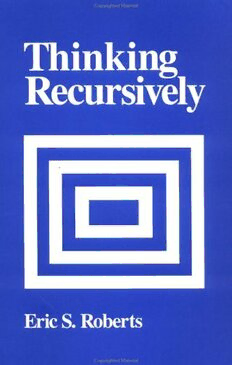Table Of ContentTHINKING
THINKING
THINKING
THINKING
THINKING
lIU\;KI:-;O
I-~.I
U....I..O
~~~
R}-(1"}I;,\IVl-lY
R[Cl'R~IV[LY
RECURSIVELY
RECURSIVELY
RECURSIVELY
RECURSIVELY
RECURSIVELY
eng
Thi
Recursively
ERIC ROBERTS
Department ofComputer Science
Wellesley College. Wellesley. Mass.
JOHN WILEY & SONS, INC.
New York' Chichester' Brisbane' Toronto' Singapore
Copyright © 1986. byJohn Wiley & Sons. Inc.
All rights reserved. Published simultaneously inCandda
Reproduction ortran~lationofany part ofthis work
beyond that permitted by Sections 107or 108ofthe 1976
United States Copyright Act without the permi'i~ionofthe
copyright owneri~ unlawful Reque~hfor permi~sionor
further information ~hould be addre~,edto the Permi~,ion'
Department. John Wiley & Son~. Inc.
LibraryofConWl'S.\' Cata/oKinK in Pub/iclition Data
Robert~. Eric.
Thinking recur~ively.
Bibliography p
Includes index.
I. Recur~ion theory. I. Title
QA9.6.R63 19115 5113 85-2036~
ISBN 0-471-81652-3
Printed in the United States ofAmerica
10 9 II 7 6 5 4 l 2 I
In loving memory of my grandmother
RUTH STENIUS ROBERTS
(1899-1982)
Preface
In
myexperience. teachingstudentsto use recursion hasalwaysbeenadifficult
task. When it is first presented. students often react with a certain suspicion
to the entire idea. as if they had just been exposed to some conjurer's trick
rather than a new programming methodology. Given that reaction. many stu
dents neverlearn toapply recursive techniques and proceedto more advanced
courses unable to write programs which depend on the use ofrecursive strat
egies. This book is intended to demystify this material and encourage the
student to "think recursively."
This book is intended for use as a supplementary text in an intermediate
course in data structures. but it could equally well be used with many other
coursesat this level. Theonly prerequisitefor usingthis text isan introductory
programming course. Since Pascal is used in the programming examples. the
student must also become familiar with Pascal programming. although this can
easily be included as part ofthe same course. To support the concurrent pre
sentation ofPascal and the material on recursion. the programming examples
in the early chapters require only the most basic features ofPascal.
In order to develop a more complete understanding of the topic. it is
important for the student toexamine recursion from several different perspec
tives. Chapter I provides an informal overview which examines the use of
recursion outside the context ofprogramming. Chapter 2examines the under
lying mathematical concepts and helps the student develop an appropriate
conceptual model. In particular. this chapter covers mathematical induction
and computational complexity in considerable detail. This discussion is de
signed to be nonthreatening to the math-anxious student and. at the same time,
include enough formal structure to emphasize the extent to which computer
science depends on mathematics for its theoretical foundations.
Chapter 3 applies the technique of recursive decomposition to various
mathematical functions and begins to show how recursion is represented in
Pascal. Chapter 4 continues this discussion in the context ofrecursive proce-
vii
viii Preface
dures, emphasizingthe parallel between recursive decompositionand the more
familiar technique ofstepwise refinement.
Chapters 5 through 9 present several examples ofthe use ofrecursion to
solveincreasingly sophisticatedproblems. Chapter7isofparticularimportance
and covers recursive sorting techniques, illustrating the applicability of the
recursion methodology to practical problem domains. Chapter9contains many
delightful examples, which make excellent exercises and demonstrations if
graphical hardware is available.
Chapter 10 examines the use of recursive procedures in the context of
recursive data structures and contains several important examples. Structur
ally, thischapterappearslateinthe text primarilyto avoid introducing pointers
prematurely. Forcourses in which the students have been introducedto point
ers relatively early, it may be useful to cover the material in Chapter 10 im
mediately after Chapter 7.
Finally, Chapter II examines the underlying implementation ofrecursion
and provides the final link in removing the mystery. On the other hand, this
materialis notessentialto the presentationand mayinterfere with the student's
conceptual understanding ifpresented too early.
I am deeply grateful for the assistance of many people who have helped
to shape the final form ofthe text. I want to express a special note ofappre
ciation to Jennifer Friedman, whose advice has been invaluable in matters of
both substance and style. I would also like to thank my colleagues on the
Wellesley faculty, Douglas Long, K. Wojtek Przytula, Eleanor Lonske, James
Finn, Randy Shull, and Don Wolitzer for their support. Joe Buhler at Reed
College, Richard Pattis at the University of Washington, Gary Ford at the
University ofColorado at Colorado Springs, Steve Berlin at M.LT., and Suz
anne Rodday (Wellesley '85) have all made important suggestions that have
dramatically improved the final result.
Eric Roberts
Contents
Preface ix
1 The Idea of Recursion 1
I-I An Illustration ofthe Recursive Approach /
1-2 Mondrian and Computer Art 4
1-3 Characteristics of Recursive Algorithms 7
1-4 Nonterminating Recursion 8
1-5 Thinking about Recursion-Two Perspectives 9
2 Mathematical Preliminaries 13
2-1 Mathematical Induction /4
2-2 Computational Complexity /9
3 Recursive Functions 31
3-1 Functional vs. Procedural Recursion 32
3-2 Factorials 32
3-3 The Fibonacci Sequence 36
4 The Procedural Approach 47
4-1 Numeric Output 49
4-2 Generating a Primer 54
ix

